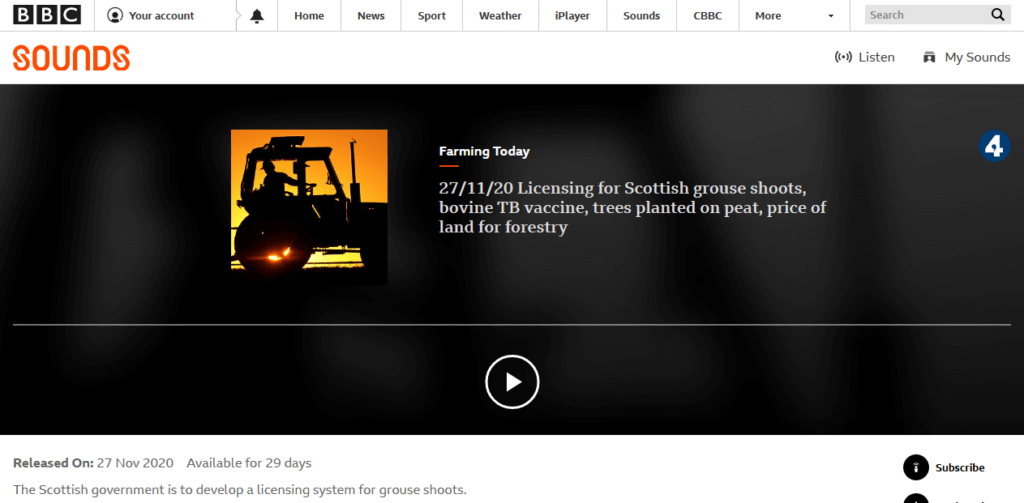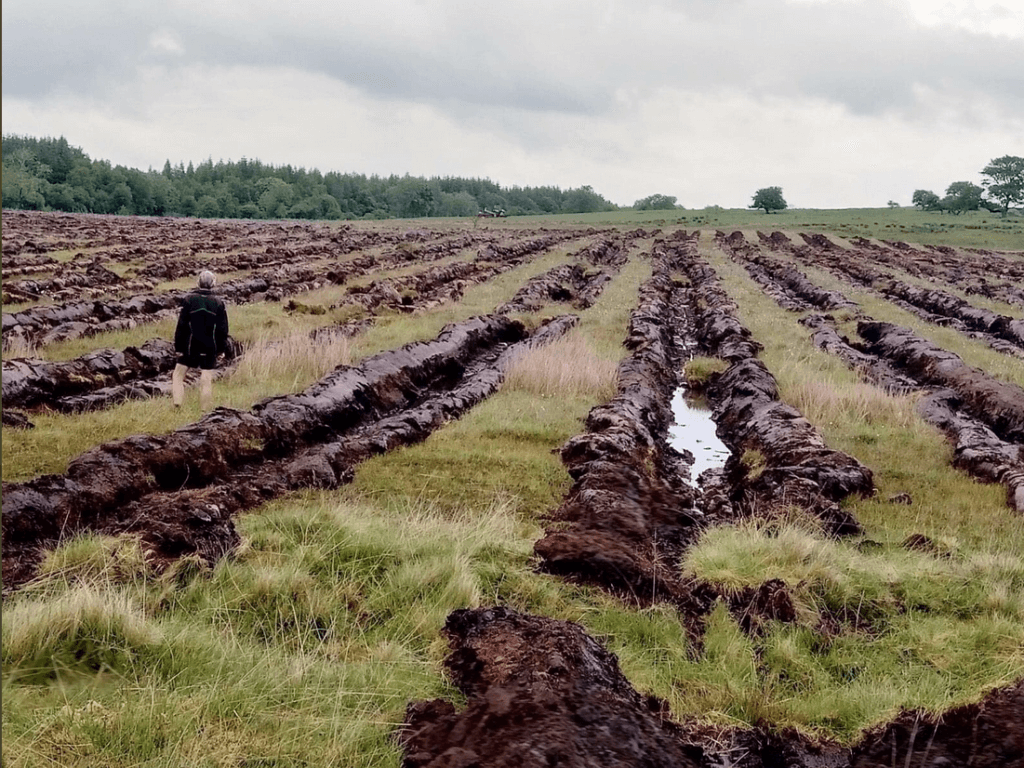

Three weeks ago Miles King had a Guest Blog here to shine a light on the outrageous planting of trees on a peat bog at Berrier in Cumbria and today Farming Today had a good piece (first 6mins of programme) on that case and the wider issue that it (and Miles) raised, about how careful we should be in our rush to plant trees to make sure they go in the right places.
A man from Tilhill spelled out the strength of the market for land with or for plantations. And then Steve Trotter from Cumbria Wildlife Trust and Josh Styles (see Amanda Tuke’s interview with Josh here) explained why trees are good, but only in the right places. The Forestry Commission has clearly cocked up here, and they seem quite embarrassed about it – that is the value of highlighting such instances oin places like this blog. The Forestry Commission haven’t, as far as I’ve seen, put anyone in front of a camera or microphone on this particular case but issued a statement which said;
We took our decision on this site based on the evidence we had at the time when we reviewed the proposal.
…which is utterly pathetic. The site is right by the road – try looking over the fence! This is an admission of failure, and I can see why nobody would want to stand by the damaged site and say that they didn’t realise it was there! Whenever you hear about all the red tape obstructing economic progress just remember this site, which is not going to be restored it seems, as an example of how thin that tape really is.

Then Farming Today moved on to Badgers again and spoke to a man, whose professorship they did mention, about why vaccination is so ‘difficult’. He explained that you can vaccinate cattle against Bovine tb but that the test used, the skin test, then reacts positive to those cattle. And he said that the way to get around this slight awkwardness is to develop a test that distinguishes between vaccinated cattle and infected ones (and that one is on the way).
We are all experts on epidemiology now so it comes as no surprise that government has bungled the handling of this infectious disease. We should have thrown money at this problem years ago, as many of us said at the time. The RSPB said it (amongst many others) back before the internet was much of a thing, otherwise I could take you to those pronouncements to show this is not being wise after the event. Instead of throwing money at vaccination of cattle and developing proper tests this government threw bullets at Badgers instead – an unbelievably poor investment driven by the misguided unscientific leaders of the farming lobby.

Farming Today then moved on to yesterday’s announcement on licensing of driven grouse shooting in Scotland and managed not to mention climate change or food standards (medicated grit) or Mountain Hare slaughter but only illegal bird of prey persecution. the Scottish government understand, although the BBC did not, that intensive grosue moor management is an issue across the board- not just wildlife crime.
Don’t get me wrong, I am very fired up by wildlife crime, but this subject is not a conflict between the deaths of a few eagles and the fragile upland communitioes of gamekeepers as it was somewhat portrayed by Farming Today.
But I do feel that Farming Today is improving and it has had a good week this week.
[registration_form]
thanks Mark. More on this story anon.
It seems to me on the face of it (and without I admit full knowledge) that there may be grounds for Judicial Review of FC here. They seem to have offered a grant without following correctly there own procedures. Do we know if anyone is investigating this option?
Apparently the hot-button issues in Mairi Gougeon’s statement yesterday to the Scottish Parliament were burning heather and medicated grit. Slaughtering, en masse, mountain hares and killing eagles didn’t get much of a mention. That could have been wanting to avoid the controversial stuff but it could also have been an attempt to frame the direction the licencing will take. There were constant references to good practice and how most estates are law-abiding, so I think we already know where this is going to end.
The weak link in the chain does seems to be burning heather or as she put it more generally muir burn. I’m not sure, again, whether this was an exercise in misdirection or deflection but it could turn out that this is the Achilles heel of driven grouse shooting. Tying it firmly to flooding, carbon storage and global warming might just make it impossible for governments not to act as it’s an extremely high profile, easy to understand argument and it’s an easy win with a large number of the electorate. Whether that pushes driven grouse shooting over the edge as it will be uneconomic with out it remains to be seen.
Of course, despite saying there was going to be action on heather burning she did give herself an out with the asinine comment that burning heather is important as it reduces fuel load and so controls wildfires. Well maybe in 100 years when it’s 10 degrees hotter.
So, in general, there was quite a lot to work with in the Scottish Governments statement but if you expect change as a result, don’t hold your breath.
Stuart – I do now expect change from the Scottish Government, but it will be up to the environmental NGOs north of the Border to makre sure that change happens and happens quickly enopugh and well enough. We southerners havee done most of our job now, to help Scotland change. We have the daunting task of getting change in Westminster on our plates.
Absolutely. We’d never have gotten to this point without you. Thanks.
I do think there will be a divergence from now on. Obviously the issue of a referendum and independence is a big driver of that as the government and to a lesser extent the population won’t be much interested in taking cues from a country that wants to leave the UK. That’s a bit of a pity as the move to licence peat burning and hare culling means that Wild Justice (Scotland) would be in a great position to hold a few feet to the fire.
FC clearly has some answers to give on the planting highlighted by Miles – but there are other players involved – immediately, the owner, and almost certainly a professional forester. There is a reasonable expectation that the owner should have had some understanding of the land & issues – after all, we are always being told that farmers know it all and the forester advising the owner definitely should have known – the professional magazines are full of peat issues. We seem to be in an era where demands for individual freedom are matched by a concomitant decline in individual responsibility.
At a wider scale, I am completely, totally fed up with people wittering ‘the right tree in the right place’ without qualifying that mindless phrase in any shape or form. I still haven’t seen a coherent statement of what it means by a single conservation body. What I have sensed is a subliminal desire not to upset farmers by suggesting there might be planting on ‘improved’ farmland supported by an assumption that nothing has changed since the 1990s – and if yous assume that, this is the planting you will end up with. I’d reiterate what I have said before, that we should be looking far further down the hill, to the lower land of the less favoured areas, not the sort of land we’re seeing ploughed here which may be useless for farming but isn’t that much better for trees. And I would like to see some sort of landuse integration where farming and woodland can be mixed into attractive landscapes – more attractive than many of the degraded landscapes many people seem so keen to ‘protect’.
As I’ve written before there’s gold in that spruce! Want to get rich? Conifer planting is going to get you there; not only in the planting but all the bolt-ons the owner gets acquiring the land. And that includes everyone, companies, landowners, land agents, and charities none are stupid if there’s money to be made then they’ll fully exploit the situation.
I have no time for the Forestry Commission; we’ve had our little run-in, they’re as welcome on this farm as Covid-19 is. But, we never learn, we are repeating exactly what we did 50-60 years ago, the mass planting of blocks of conifer trees, but this time we wrap it up in a PR environmental wrapper, but its not about saving this planet its about making a lot of money very quickly with the excuse that its good for the planet – crap! Covid-19 showed us how to do that for 2 months, stop excessive human activity.
On this very site we had a featured blog advocating the planting of millions of American conifers as a solution to get to net zero, now I would have thought that this country has had enough of introduced foreign pathogens at the moment, without planting the bloody thing, duh! really intelligent!
We are not enlightened, we have a short memory span based on financial gain, so, in 50 years time hopefully there will be another bloke on a farm, cutting down this crap, exasperated that those before didn’t have the wit or intelligence to at least attempt a rewilding scenario.
If we want wildlife to flourish, then we either let natural regrowth occur or we make the decision to plant new forests of oak, beech and ash. Conifer? Yes, but where they should be growing, and not in regimental rows. It won’t make you any money but perhaps leave a legacy to future generations, so at the least they don’t think we were a bunch of mutton-heads.
“He explained that you can vaccinate cattle against Bovine tb but that the test used, the skin test, then reacts positive to those cattle.”
And how long has it been that way?